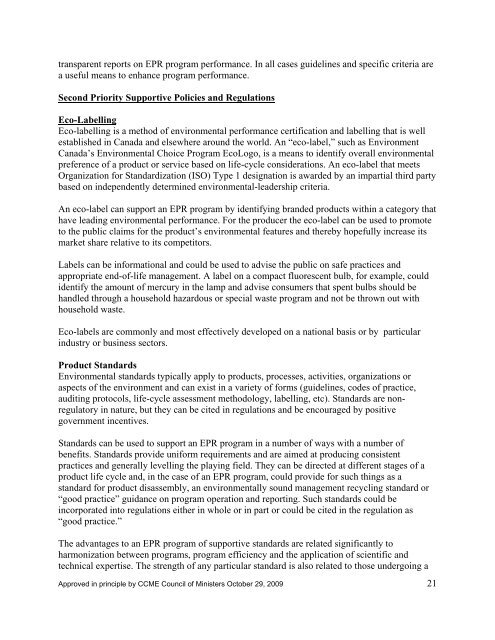Canada-Wide Action Plan for Extended Producer ... - CCME
Canada-Wide Action Plan for Extended Producer ... - CCME
Canada-Wide Action Plan for Extended Producer ... - CCME
You also want an ePaper? Increase the reach of your titles
YUMPU automatically turns print PDFs into web optimized ePapers that Google loves.
transparent reports on EPR program per<strong>for</strong>mance. In all cases guidelines and specific criteria are<br />
a useful means to enhance program per<strong>for</strong>mance.<br />
Second Priority Supportive Policies and Regulations<br />
Eco-Labelling<br />
Eco-labelling is a method of environmental per<strong>for</strong>mance certification and labelling that is well<br />
established in <strong>Canada</strong> and elsewhere around the world. An “eco-label,” such as Environment<br />
<strong>Canada</strong>’s Environmental Choice Program EcoLogo, is a means to identify overall environmental<br />
preference of a product or service based on life-cycle considerations. An eco-label that meets<br />
Organization <strong>for</strong> Standardization (ISO) Type 1 designation is awarded by an impartial third party<br />
based on independently determined environmental-leadership criteria.<br />
An eco-label can support an EPR program by identifying branded products within a category that<br />
have leading environmental per<strong>for</strong>mance. For the producer the eco-label can be used to promote<br />
to the public claims <strong>for</strong> the product’s environmental features and thereby hopefully increase its<br />
market share relative to its competitors.<br />
Labels can be in<strong>for</strong>mational and could be used to advise the public on safe practices and<br />
appropriate end-of-life management. A label on a compact fluorescent bulb, <strong>for</strong> example, could<br />
identify the amount of mercury in the lamp and advise consumers that spent bulbs should be<br />
handled through a household hazardous or special waste program and not be thrown out with<br />
household waste.<br />
Eco-labels are commonly and most effectively developed on a national basis or by particular<br />
industry or business sectors.<br />
Product Standards<br />
Environmental standards typically apply to products, processes, activities, organizations or<br />
aspects of the environment and can exist in a variety of <strong>for</strong>ms (guidelines, codes of practice,<br />
auditing protocols, life-cycle assessment methodology, labelling, etc). Standards are nonregulatory<br />
in nature, but they can be cited in regulations and be encouraged by positive<br />
government incentives.<br />
Standards can be used to support an EPR program in a number of ways with a number of<br />
benefits. Standards provide uni<strong>for</strong>m requirements and are aimed at producing consistent<br />
practices and generally levelling the playing field. They can be directed at different stages of a<br />
product life cycle and, in the case of an EPR program, could provide <strong>for</strong> such things as a<br />
standard <strong>for</strong> product disassembly, an environmentally sound management recycling standard or<br />
“good practice” guidance on program operation and reporting. Such standards could be<br />
incorporated into regulations either in whole or in part or could be cited in the regulation as<br />
“good practice.”<br />
The advantages to an EPR program of supportive standards are related significantly to<br />
harmonization between programs, program efficiency and the application of scientific and<br />
technical expertise. The strength of any particular standard is also related to those undergoing a<br />
Approved in principle by <strong>CCME</strong> Council of Ministers October 29, 2009 21
















